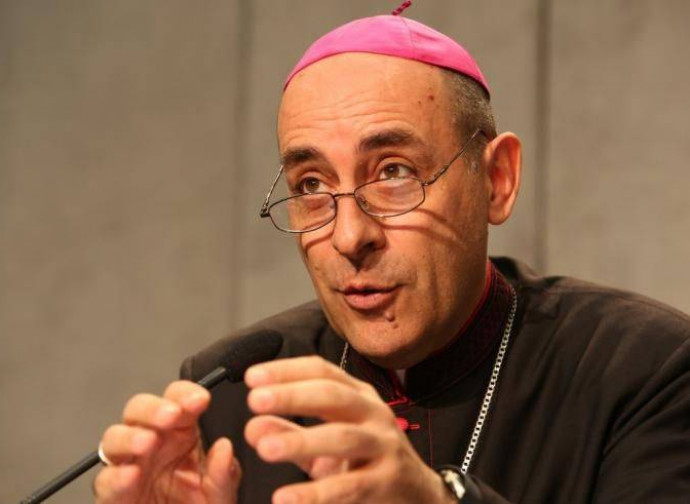Fernández's latest mess over the use of title 'Co-Redemptrix'
In response to journalist Diane Montagna, the Prefect of the CDF explained that the title of 'Co-Redemptrix' should no longer be used in liturgical texts or Vatican documents. However, it could still be used among friends after reading and understanding the 'Mater Populi Fidelis'. This is an incredible blunder which creates a rift within the Church. The case of the 'mutinous' Mariologists.

In no way has the change of pope benefited the Cardinal Prefect of the Congregation for the Doctrine of the Faith(CDF), which suggests that the problem is structural. We recall him for the blessings for homosexual couples, which were perhaps intended for individuals presenting themselves as couples and which, in any case, should last only a few seconds. Then came the new rules on apparitions — another example of overcomplicating simple matters — with six options that not even the experts understood. Victor Manuel Fernández now explains that the title of Co-Redemptrix is always inappropriate, at least in official documents, although it can be used informally among friends, provided they have read the Doctrinal Note.
Thanks to an exchange between Diane Montagna and Fernández, we now have these new clarifications from the Prefect: 'If you, together with your group of friends, believe you understand well the true meaning of this expression, have read the document, and see that its positive aspects are also affirmed there, and you wish to express precisely that within your prayer group or among friends, you may use the title - but it will not be used officially, that is, either in liturgical texts or in official documents.' Therefore, the title of 'Co-Redemptrix' is permitted among friends, but it is unclear what will happen if these friends have not read the Note or interpreted it differently to Tucho. It is also unclear what will happen to those who have the title 'Co-Redemptrix' in their official name, such as the Congregation of the Daughters of Mary Most Holy Co-Redemptrix, founded by Don Dante Forno and Sister Maria Salemi in 1956. Perhaps the Dicastery will write a separate clarification.
In any case, we note that the Note, which was written to protect the simplest of the faithful from doubts that Our Lady competes with Jesus Christ, dethroning him as the only Redeemer, actually permits them to continue using the term 'Co-Redemptrix'. However, the term can no longer appear in official documents, where the title 'Mater Populi Fidelis' is to be preferred — a term that the 'faithful people' have never used. This is an incredible blunder which will only serve to create a rift between the people's faith and the Church's documents and liturgy. However, despite the intentions of those who created this division, it once again demonstrates that it will be the Christian people, not certain pastors, who preserve the true faith in times of crisis.
However, Cardinal Fernández reassures us that it is only the term that is banned, and that we can continue to uphold 'Mary's unique cooperation in the work of Redemption'. This expression is supposedly found 'at least 200 times in the document'. This is a generous estimate though, as Diane Montagna's research found that the expression occurs only once, in §3, and only within a question. The adjectives 'unique' and 'only' appear about thirty times in total. But if Tucho says there are 200 instances, then there must be, by virtue of obedience of the will and intellect.
Numbers aside, perhaps Fernández has failed to understand that the issue at stake is precisely that the nature of this cooperation is never expressed in the document. While the Magisterium has certainly emphasised the singularity and uniqueness of Mary's cooperation in the Redemption, it has also specified its nature. For example, in the encyclical Mystici Corporis, Pius XII indicated that 'always closely united with her Son, Mary offered Him to the Eternal Father on Golgotha, making a sacrifice of all her maternal rights and her maternal love, as the new Eve, for all the children of Adam contaminated by his miserable transgression'. This text unequivocally reveals that Mary's cooperation was active, immediate, and universal. Similarly, in his homily in Guayaquil on 31 January 1985, John Paul II stated that Mary was 'spiritually crucified with her crucified Son' on Calvary, when 'she joined in the sacrifice of her Son, which was aimed at founding the Church', thus playing a 'co-redemptive role'.
Even more curiously, John Paul II continued to specify the nature of Mary's cooperation in the Redemption even after the fateful Feria IV of 21 February 1996, pointing out that her contribution 'took place during the event itself [of Calvary] as a mother, and therefore extends to the totality of Christ's saving work'. She alone was associated in this way with the redemptive offering that merited the salvation of all men. In union with Christ and submissive to Him, she cooperated in obtaining the grace of salvation for the whole of humanity.’ Once again, these characteristics indicate not only 'singular' cooperation, but also active, immediate and universal cooperation. This cooperation is repeatedly present in the ordinary Magisterium, yet it is not acknowledged in the Note.
Regarding Feria IV and Ratzinger: The version given to us in the Doctrinal Note is that Ratzinger had responded in his particular votum to the question of whether the request of the Vox Populi Mariae Mediatrici movement was acceptable in view of defining the dogma of Mary as Co-Redemptrix or Mediatrix of all graces. It would be interesting to know the other opinions as well. Therefore, the question concerned the appropriateness of a dogmatic definition, not the use of the two terms. The answer was negative, but not absolutely so, as Ratzinger explained that 'the precise meaning of the titles is unclear, and the doctrine contained therein is not well-established', and that 'it is not yet clear how the doctrine expressed in the titles is present in Scripture and in apostolic tradition'. These expressions leave open the possibility of maturation and clarification, and cannot be used to justify a definitive solution such as that presented in the Note. Therefore, it is incorrect to use this votum – which remains an authoritative, albeit non-binding, opinion – to claim that the term 'Co-Redemptrix' can no longer be used officially.
However, something even more curious emerges from the interview with Tucho. When Montagna asked whether the Dicastery had consulted with mariologists when drafting the Note, Fernández replied, 'Yes, many, as well as theologians specialising in Christology.' Yet things do not seem quite so. This is because Father Maurizio Gronchi, a consultant to the Congregation for the Doctrine of the Faith who was chosen to accompany the prefect and secretary at the presentation of the doctrinal note, revealed in an interview with CNA that 'it was not possible to find any mariologists willing to collaborate'. It's a Pirandellian evolution in reverse: from Tucho's hundred thousand to Gronchi's none.
Not only did the Dicastery not consult any Mariologists, but it seems that the Mariology experts themselves were also not 'willing to collaborate'. In fact, Gronchi himself pointed out that no professor from the Pontifical Marianum Theological Faculty or any member of the Pontifical International Marian Academy — an institution of the Holy See — was present at the presentation of the document. Gronchi admits that this absence could be interpreted as dissent. This mutiny is incredible and shows that Tucho's approach was not appreciated by the diverse world of Mariologists. The absence of Mariology experts was also confirmed in an interview with Fr Salvatore Maria Perrella, who pointed out that the document needed to be better thought out and refined, and that it should be based on a study carried out by competent people. This is a polite way of hinting at the inexperience of those who produced the note.




